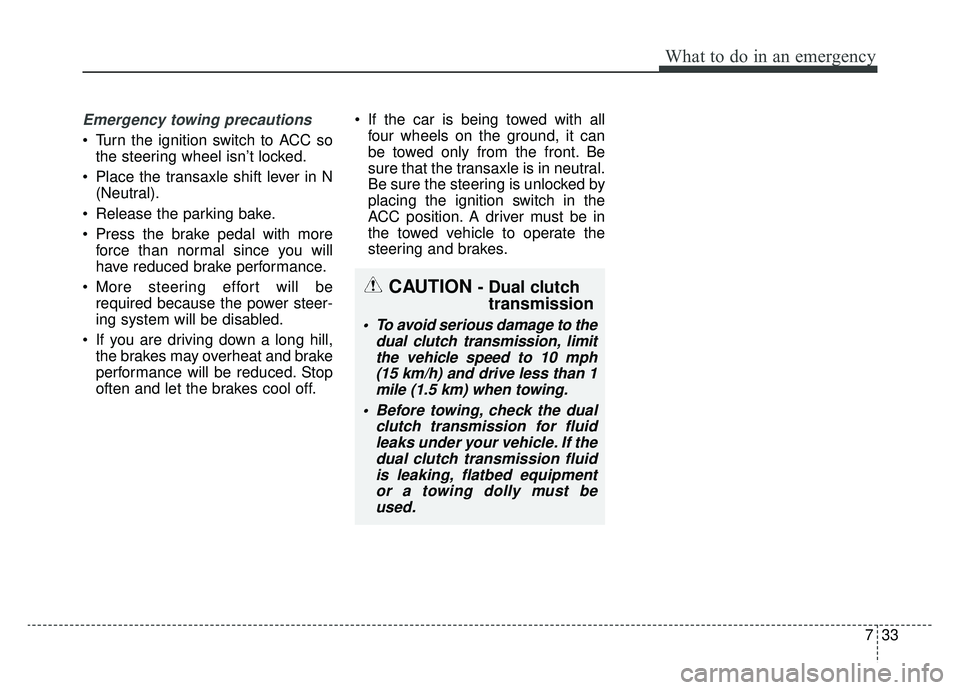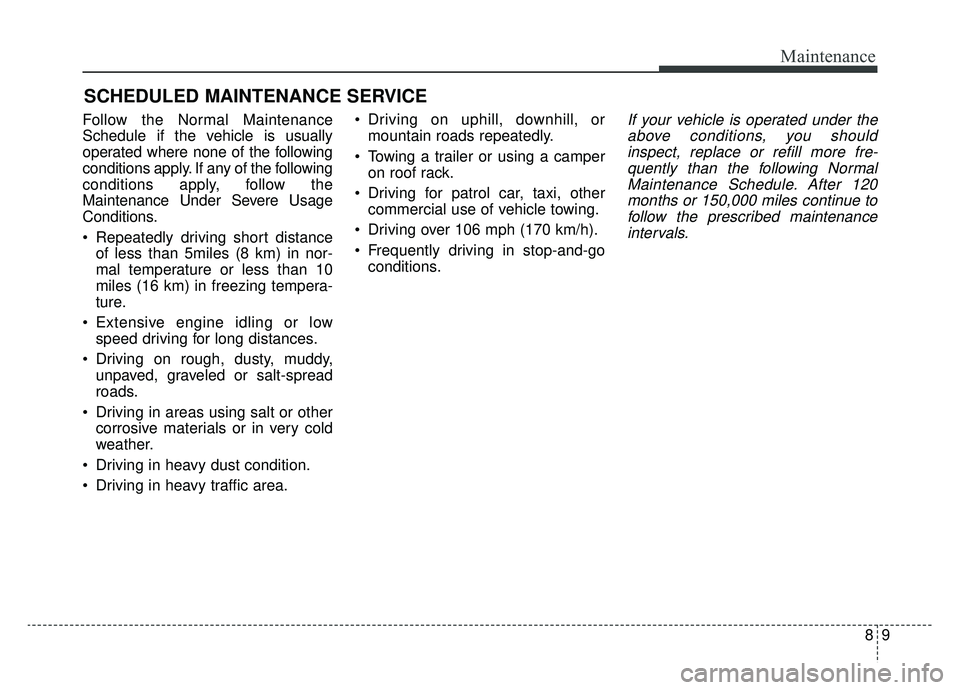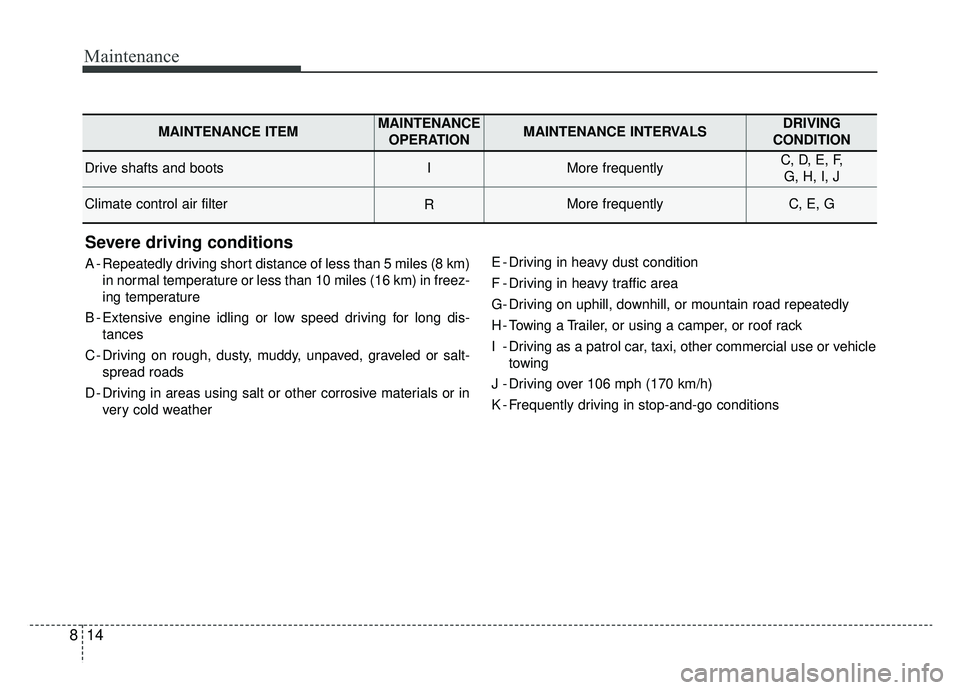2019 KIA NIRO tow
[x] Cancel search: towPage 473 of 611

733
What to do in an emergency
Emergency towing precautions
Turn the ignition switch to ACC sothe steering wheel isn’t locked.
Place the transaxle shift lever in N (Neutral).
Release the parking bake.
Press the brake pedal with more force than normal since you will
have reduced brake performance.
More steering effort will be required because the power steer-
ing system will be disabled.
If you are driving down a long hill, the brakes may overheat and brake
performance will be reduced. Stop
often and let the brakes cool off. If the car is being towed with all
four wheels on the ground, it can
be towed only from the front. Be
sure that the transaxle is in neutral.
Be sure the steering is unlocked by
placing the ignition switch in the
ACC position. A driver must be in
the towed vehicle to operate the
steering and brakes.
CAUTION - Dual clutchtransmission
To avoid serious damage to the
dual clutch transmission, limitthe vehicle speed to 10 mph(15 km/h) and drive less than 1mile (1.5 km) when towing.
Before towing, check the dual clutch transmission for fluidleaks under your vehicle. If thedual clutch transmission fluidis leaking, flatbed equipmentor a towing dolly must beused.
Page 474 of 611

IF AN ACCIDENT OCCURS
✽ ✽ NOTICE
Any gas or electrolyte leakage from
your vehicle is not only poisonous
but also flammable. Upon witness-
ing one of those, make sure your car
is parked in a safe area away from
any roads, open the windows, and
maintain a safe distance away from
the vehicle. Immediately contact an
authorized Kia dealer and advise
them that a hybrid vehicle is
involved.
If you need towing, refer to
"Towing" in the previous pages.
When the vehicle is severely dam- aged, remain a safe distance of 50
feet (15 meter) or more between
your vehicle and other
vehicles/flammables.
If a fire occurs :
Immediately call emergency services
(911) and advise the emergency
responders that a hybrid vehicle is
involved.
WARNING - High voltage components
For your safety, do not touch high voltage cables, connec-
tors and package modules.
High voltage components are
orange in color.
Exposed cables or wires may be visible inside or outside of
the vehicle. Never touch the
wires or cables, because an
electrical shock, an injury, or a
death may occur.WARNING- Submersion
in water
Do not touch your vehicle if it
has been submerged in water.
The high-voltage battery may
cause shock or may catch fire.
Immediately contact the author-
ities and advise them of the
condition of your vehicle and
that a hybrid vehicle is involved.
734
What to do in an emergency
Page 483 of 611

89
Maintenance
SCHEDULED MAINTENANCE SERVICE
Follow the Normal Maintenance
Schedule if the vehicle is usually
operated where none of the following
conditions apply. If any of the following
conditions apply, follow the
Maintenance Under Severe Usage
Conditions.
Repeatedly driving short distanceof less than 5miles (8 km) in nor-
mal temperature or less than 10
miles (16 km) in freezing tempera-
ture.
Extensive engine idling or low speed driving for long distances.
Driving on rough, dusty, muddy, unpaved, graveled or salt-spread
roads.
Driving in areas using salt or other corrosive materials or in very cold
weather.
Driving in heavy dust condition.
Driving in heavy traffic area. Driving on uphill, downhill, or
mountain roads repeatedly.
Towing a trailer or using a camper on roof rack.
Driving for patrol car, taxi, other commercial use of vehicle towing.
Driving over 106 mph (170 km/h).
Frequently driving in stop-and-go conditions.If your vehicle is operated under theabove conditions, you shouldinspect, replace or refill more fre-quently than the following NormalMaintenance Schedule. After 120months or 150,000 miles continue tofollow the prescribed maintenanceintervals.
Page 488 of 611

Maintenance
14
8
Severe driving conditions
A - Repeatedly driving short distance of less than 5 miles (8 km)
in normal temperature or less than 10 miles (16 km) in freez-
ing temperature
B - Extensive engine idling or low speed driving for long dis- tances
C - Driving on rough, dusty, muddy, unpaved, graveled or salt- spread roads
D - Driving in areas using salt or other corrosive materials or in very cold weather E - Driving in heavy dust condition
F - Driving in heavy traffic area
G- Driving on uphill, downhill, or mountain road repeatedly
H - Towing a Trailer, or using a camper, or roof rack
I - Driving as a patrol car, taxi, other commercial use or vehicle
towing
J - Driving over 106 mph (170 km/h)
K - Frequently driving in stop-and-go conditions
MAINTENANCE ITEMMAINTENANCE OPERATIONMAINTENANCE INTERVALSDRIVING
CONDITION
Drive shafts and bootsIMore frequentlyC, D, E, F, G, H, I, J
Climate control air filterRMore frequentlyC, E, G
Page 495 of 611

821
Maintenance
COOLANT
The high-pressure cooling system
has a reservoir filled with year round
antifreeze coolant. The reservoir is
filled at the factory.
Check the antifreeze protection and
coolant level at least once a year: at
the beginning of the winter season,
and before traveling to a colder cli-
mate.Checking the coolant level Turn the engine off and wait until itcools down. Use extreme care
when removing the radiator cap.
Wrap a thick towel around it, and
turn it counterclockwise slowly to
the first stop. Step back while the
pressure is released from the cool-
ing system.
When you are sure all the pressure
has been released, press down on
the cap, using a thick towel, and
continue turning counterclockwise
to remove it.
Even if the engine is not operating, do not remove the radiator cap or
the drain plug while the engine and
radiator are hot. Hot coolant and
steam may still blow out under
pressure, causing serious injury.
The engine coolant and/or inverter
coolant level is influenced by the
hybrid system temperature. Before
checking or refilling the engine
coolant and/or inverter coolant,
turn the hybrid vehicle off.
WARNING
Removing radiator
cap
Never attempt to remove the
radiator cap while the engine is
operating or hot. Doing so
might lead to cooling system
and engine damage and could
result in serious personal injury
from escaping hot coolant or
steam.
CAUTION - Radiator cap
Never attempt to remove theradiator cap while the engine isoperating or hot. Doing somight lead to cooling systemand engine damage.
Page 609 of 611

Index
10I
Tire maintenance . . . . . . . . . . . . . . . . . . . . . . . . . . . 8-46
Tire pressure . . . . . . . . . . . . . . . . . . . . . . . . . . . . . . . 8-42
Tire replacement . . . . . . . . . . . . . . . . . . . . . . . . . . . . 8-45
Tire rotation . . . . . . . . . . . . . . . . . . . . . . . . . . . . . . . 8-43
Tire sidewall labeling . . . . . . . . . . . . . . . . . . . . . . . . 8-46
Tire terminology and definitions . . . . . . . . . . . . . . . 8-50
Tire traction . . . . . . . . . . . . . . . . . . . . . . . . . . . . . . . 8-46
Wheel alignment and tire balance . . . . . . . . . . . . . 8-44
Wheel replacement . . . . . . . . . . . . . . . . . . . . . . . . . 8-45
Towing . . . . . . . . . . . . . . . . . . . . . . . . . . . . . . . . . . . . \
. 7-29 Emergency towing . . . . . . . . . . . . . . . . . . . . . . . . . . 7-31
Removable towing hook. . . . . . . . . . . . . . . . . . . . . . 7-30
Towing service . . . . . . . . . . . . . . . . . . . . . . . . . . . . . 7-29
Trailer towing . . . . . . . . . . . . . . . . . . . . . . . . . . . . . . . . 6-99
Vehicle break-in process . . . . . . . . . . . . . . . . . . . . . . . . . 1-5
Vehicle certification label . . . . . . . . . . . . . . . . . . . . . . . 9-10
Vehicle data collection and event data recorders . . . . . . 1-6
Vehicle identification number (VIN) . . . . . . . . . . . . . . . 9-9
Vehicle load limit . . . . . . . . . . . . . . . . . . . . . . . . . . . . 6-100 Certification label . . . . . . . . . . . . . . . . . . . . . . . . . . 6-103
Tire and loading information label. . . . . . . . . . . . . 6-100
Vehicle weight . . . . . . . . . . . . . . . . . . . . . . . . . . . . . . 6-104 Base curb weight . . . . . . . . . . . . . . . . . . . . . . . . . . 6-104
Cargo weight . . . . . . . . . . . . . . . . . . . . . . . . . . . . . 6-104 GAW (Gross Axle Weight). . . . . . . . . . . . . . . . . . . 6-104
GAWR (Gross Axle Weight Rating) . . . . . . . . . . . 6-104
GVW (Gross Vehicle Weight) . . . . . . . . . . . . . . . . 6-104
GVWR (Gross Vehicle Weight Rating) . . . . . . . . . 6-104
Vehicle curb weight . . . . . . . . . . . . . . . . . . . . . . . . 6-104
Warning and indicator lights. . . . . . . . . . . . . . . . . . . . . 4-94 Indicator lights . . . . . . . . . . . . . . . . . . . . . . . . . . . . 4-102
Warning lights . . . . . . . . . . . . . . . . . . . . . . . . . . . . . 4-94
Washer fluid . . . . . . . . . . . . . . . . . . . . . . . . . . . . . . . . . 8-29 Checking the washer fluid level . . . . . . . . . . . . . . . 8-29
Welcome system . . . . . . . . . . . . . . . . . . . . . . . . . . . . . 4-128 Headlight (Headlamp) escort function . . . . . . . . . . 4-128
Interior light . . . . . . . . . . . . . . . . . . . . . . . . . . . . . . 4-128
Pocket lamp . . . . . . . . . . . . . . . . . . . . . . . . . . . . . . 4-128
Windows . . . . . . . . . . . . . . . . . . . . . . . . . . . . . . . . . . . . \
4-27 Power windows . . . . . . . . . . . . . . . . . . . . . . . . . . . . 4-28
Windshield defrosting and defogging. . . . . . . . . . . . . 4-145 Automatic climate control system . . . . . . . . . . . . . 4-145
Defogging logic . . . . . . . . . . . . . . . . . . . . . . . . . . . 4-146
Winter driving . . . . . . . . . . . . . . . . . . . . . . . . . . . . . . . . 6-96 Carry emergency equipment . . . . . . . . . . . . . . . . . . 6-99
Change to "winter weight" oil if necessary . . . . . . . 6-98
Check battery and cables . . . . . . . . . . . . . . . . . . . . . 6-98
Check spark plugs and ignition system . . . . . . . . . . 6-98
V
W